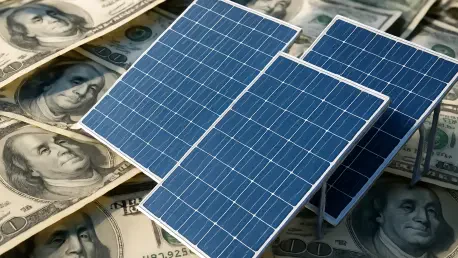What happens when an industry vital to global sustainability faces a staggering 39% drop in funding, yet buzzes with more deals than ever? In the solar and energy storage sectors, a striking contradiction is unfolding this year. Corporate investments are plummeting, with solar funding down by nearly two-fifths and storage by over 41%, yet mergers, acquisitions, and project transactions are on the rise. This paradox paints a complex picture of caution and opportunity, begging the question: what drives this divide, and what does it mean for the future of renewable energy?
A Curious Split in Renewable Energy Markets
The renewable energy landscape is caught in a fascinating tug-of-war. On one hand, financial backing for solar and storage companies has taken a severe hit, with public market financing for solar alone collapsing by 73%, from $1.7 billion to just $467 million. On the other hand, dealmaking is thriving, as nearly 20 gigawatts of solar assets changed hands this year—a slight uptick from last year’s 18.5 gigawatts. This split suggests a market where investors are wary of new capital commitments but eager to seize existing opportunities at lower valuations.
This dynamic is more than a curiosity; it reflects deeper shifts in strategy and sentiment. While funding dries up for early-stage ventures, the surge in transactions indicates a focus on consolidation over innovation. Industry players seem to be playing a cautious game, prioritizing established assets over risky new projects. The question remains whether this trend signals a temporary adjustment or a lasting pivot in how renewables are financed.
The Critical Role of Solar and Storage Today
Solar and storage technologies stand as pillars of the transition to a cleaner energy grid, fueling everything from residential rooftops to the massive data centers powering artificial intelligence. Their importance cannot be overstated in an era where energy security and climate targets dominate global agendas. Yet, with funding for these sectors down sharply, the ability to scale solutions and meet rising demand is under threat, raising concerns about stalled progress at a pivotal moment.
Beyond immediate impacts, this funding slump ripples through economies and communities reliant on renewable growth. Jobs, infrastructure, and innovation hang in the balance as investor hesitancy grows. Meanwhile, the uptick in dealmaking hints at a silver lining—strategic moves that could reshape the industry’s structure. Understanding this tension is essential for stakeholders aiming to navigate an increasingly unpredictable energy landscape.
Breaking Down the Funding Fall and Dealmaking Rise
Funding Decline: A Perfect Storm of Challenges
A closer look at the numbers reveals a grim reality for renewable financing. Solar corporate funding has dropped by 39% compared to last year, while storage faces an even steeper 41% decline across venture capital, private equity, and public markets. Policy uncertainty, particularly surrounding the early phase-out of tax credits under recent legislation, has rattled investors, prompting a pullback from high-risk investments in unproven projects.
Dealmaking Surge: Capitalizing on Lower Valuations
In stark contrast, the market for mergers, acquisitions, and project transactions is heating up. Storage project acquisitions have doubled this year, while solar asset turnovers reached 20 gigawatts, edging past last year’s figures. With valuations suppressed due to funding shortages, investment firms and utilities are pouncing on bargains, opting to build portfolios through acquisitions rather than funding new developments from the ground up.
Divergent Paths: Solar’s Edge Over Storage
The two sectors, though intertwined, are not faring equally. Solar shows glimmers of recovery, with debt financing ticking up in recent months, suggesting some projects are restarting. Storage, however, lags in merger activity, with deal counts dropping from 14 to just 3, though interest in operational assets remains robust. These differences highlight how market forces and investor priorities are shaping distinct trajectories for each technology.
Expert Perspectives and Market Indicators
Insights from industry leaders shed light on this unusual moment. A prominent analyst notes that investors are deterred by ambiguity, especially with policy shifts creating unpredictability in returns. However, finalized regulations through recent Congressional actions could provide much-needed stability, allowing firms to plan with clearer expectations. This perspective suggests that while the current environment is tough, a path to recovery may be emerging as the rules become defined.
Market signals also point to cautious optimism. Venture capitalists are exploring alternative storage solutions like sodium-based batteries, betting on niche innovations to break through funding barriers. In solar, smaller deal counts have risen from 29 to 32, even as total deal value halved, indicating a shift toward more targeted investments. These trends reflect a sector recalibrating—neither retreating nor charging ahead, but carefully repositioning for what lies next.
Strategies for Thriving in a Shifting Landscape
Investors: Targeting Tactical Wins
For those with capital to deploy, the current market offers unique openings. Focusing on undervalued assets and smaller-scale deals can yield returns with lower risk, as seen in the high volume of solar asset transactions. Prioritizing operational projects over speculative ventures provides a buffer against ongoing uncertainties, positioning investors to capitalize on eventual market stabilization.
Companies: Innovating to Stay Relevant
Solar and storage firms must adapt swiftly to survive. Solar companies can take advantage of rising debt financing to revive delayed initiatives, while storage players might explore cutting-edge technologies to attract specialized funding. Aligning with growing demands, such as powering AI-driven data centers, could also secure a competitive edge in a crowded field.
Policymakers: Building a Stable Foundation
Clarity in policy remains a linchpin for industry recovery. Accelerating consistent guidelines on incentives, even if less favorable, would enable better strategic planning across the board. Coupling this with support for research and development can sustain momentum, ensuring that short-term funding gaps do not derail long-term renewable goals.
Reflecting on a Paradox That Shaped the Industry
Looking back, the sharp divide between dwindling funds and booming deals in solar and storage revealed a sector at a crossroads. Investors who hesitated to fund new ideas instead hunted for value in existing assets, while companies grappled with uncertainty yet found ways to pivot. This period underscored a fundamental truth: resilience often emerges from constraint, as strategic moves filled the gaps left by caution.
As the dust settled, the path forward became clearer for those willing to act. Stakeholders needed to prioritize adaptability—whether through snapping up undervalued opportunities, innovating in technology, or advocating for stable policies. The lessons from this era pointed to a future where calculated risks and alignment with emerging energy needs, like AI infrastructure, would define success in renewables.









